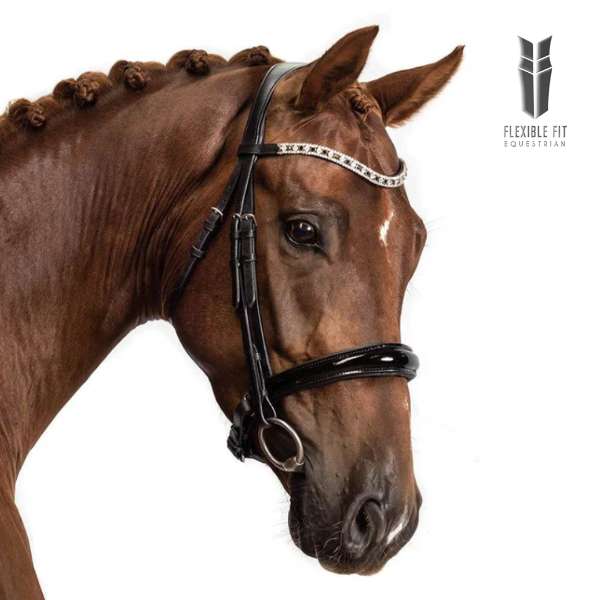A bridle is a fundamental part of a horse's headgear, used primarily to direct and communicate with the horse. It is essential for control and guidance while riding. Bridles come in different sizes, including pony, cob, horse, and oversized, and should be properly fitted to ensure the horse’s comfort and effective communication between rider and horse.
Types of Horse Bridles
Bridles are broadly categorized into two types: English Bridles and Western Bridles. The key difference lies in the riding discipline they are used for, with English bridles being used in English riding disciplines and Western bridles in Western riding disciplines.
Western Bridle
Western bridles typically lack nosebands and browbands. They are often paired with a Pelham bit or curb bit, which combines a snaffle with side orbit limbs. In Western riding, communication is minimal, with riders relying on their seat, weight, and neck-reining to guide the horse.
What is a Western Bridle?
Western bridles are designed for comfort, simplicity, and functionality, especially for long-distance riding. Unlike English bridles, they typically lack a noseband and often do not feature a traditional browband. In Western riding, riders use looser reins, holding them in one hand while controlling the horse through their seat, weight, and neck reining. This contrasts with the English riding style, where riders use both hands independently to give instructions.
Western bridles are used across various Western disciplines, including trail riding, rodeos, reining, and by cowboys and cattle ranchers. Western reins are longer and have split ends, unlike the shorter reins typically seen in English riding. These bridles can be made from leather or synthetic materials and consist of a headstall, two cheekpieces, a bit (usually a snaffle or curb bit), and a set of reins. There are three main types of Western bridles: the working bridle, the one-ear bridle, and the two-ear bridle.
What is a Western Working Bridle?
A working bridle is a straightforward, no-frills option typically used for everyday riding. It features a browband, headstall, and bit, and is designed to be practical and functional. The bridle includes a throatlatch to keep it securely in place and is commonly paired with a curb bit.
What is a One-Ear Bridle?
A one-ear bridle replaces the traditional browband with a leather loop (or a split headstall) that fits over one of the horse's ears. This design is particularly useful for horses that are uncomfortable with a straight-across browband.
What is a Two-Ear Bridle?
A two-ear bridle is similar to the one-ear version, but it has two separate leather loops that sit over each of the horse’s ears. These bridles typically do not have a throatlatch and are often reserved for showing in the ring.
While Western bridles are most commonly used in the US, there is growing interest in Western riding in the UK, with many clubs and associations promoting it. The prices of Western bridles vary significantly, from simple, functional designs to highly decorative show bridles.
English Bridle
English bridles are commonly divided into two types: Single/Snaffle Bridles and Double Bridles. The snaffle bridle features one bit and one set of reins, suitable for novice riders. A double bridle, on the other hand, uses two bits and two sets of reins for greater control. A bridle without a bit is referred to as a Hackamore. The most basic and straightforward English bridle is the Snaffle Bridle.
Parts of an English Bridle
Crownpiece: The central strap that secures the bridle behind the horse's ears.
Browband: The band that runs across the forehead, preventing the bridle from sliding back.
Noseband: Encircles the horse's nose, helping to keep the mouth closed or hold other equipment like martingales.
Cavesson: A type of noseband that attaches to the headstall and is secured by the browband.
Throatlatch: The strap that runs under the throat, preventing the bridle from slipping off.
Cheekpieces: The straps that hold the bit in place, ensuring the bit sits in the correct position.
Reins: The connecting piece between the bit and the rider, allowing communication and control.
Bit: A metal piece that sits inside the horse's mouth, providing direct control over the horse.
Flash: A thin strap attached to the noseband to keep the horse's mouth closed and stabilize the bit.
Types of English Bridles
There are several types of English bridles used in various disciplines. Below are some of the most commonly used ones:
Jumping/Snaffle Bridles: The most versatile bridle, used for jumping, dressage, and trail riding. It can be paired with various types of bits.
Dressage/Crank Bridles: Typically black and padded, often featuring a flash noseband, used in dressage for greater control.
Figure 8/Mexican/Grackle Bridles: These bridles feature a noseband that crosses over the horse's face, providing better airflow and control over the mouth.
Hunter Bridles: Used in hunter or show jumping rings, these bridles offer a classic appearance with a variety of styles.
Weymouth/Double Bridles: Used in advanced dressage, these bridles use two bits— a bradoon and a curb bit— and require two sets of reins for precise control.
Bitless Bridles: These bridles provide control without the use of a bit, often used for horses with dental issues or for retraining.
Drop Noseband Bridles: These bridles feature a noseband that rests lower on the horse’s nose, offering additional control during dressage or eventing.
Horse Reins
Reins are crucial for maintaining communication between the horse and rider. They come in various types based on style and material:
Laced Reins: A classic, often used for schooling or shows. The lacing provides a better grip for the rider.
Rubber Reins: Known for their excellent grip, especially popular in the UK and Europe.
Side Reins: Used when longeing a horse, they connect the bit to the saddle or surcingle.
Hunter Reins: Designed to match hunter bridles, they are typically used in show jumping and eventing.
Plain Reins: Long leather straps that offer an elegant look, often used in dressage but can become slippery when wet.
Conclusion
Understanding the types of bridles available, including their components and usage, is essential for every rider. Whether you’re using an English or Western bridle, choosing the right type will ensure both comfort for the horse and effective communication between rider and horse. Each type of bridle and rein has its specific purpose, making it essential to select the right one for your discipline and riding style.
Sure! Here’s a compiled list of FAQs based on the articles for English Bridles and Western Bridles:
People Also Asked: English & Western Bridles
1. What is the main difference between an English bridle and a Western bridle?
The main difference lies in their design and purpose. English bridles are typically more structured with a noseband and browband, used in disciplines like dressage, jumping, and eventing. Western bridles, on the other hand, are simpler and often lack a noseband or browband, designed for long-distance riding and disciplines like rodeo, reining, and trail riding. Western riders often use neck reining, whereas English riders use both hands independently.
2. What parts make up an English bridle?
An English bridle consists of several key components: the crownpiece (holds the bridle in place behind the ears), browband (prevents slipping), noseband (holds the mouth closed or supports additional equipment), cheekpieces (secure the bit), reins (connect the rider to the horse), and bit (controls the horse’s mouth). Other parts may include a throatlatch and flash.
3. What are the different types of English bridles?
The most common types of English bridles are:
Snaffle Bridle: Used for most disciplines, featuring one bit and one set of reins.
Double Bridle: Features two bits and two sets of reins, used for advanced dressage.
Dressage Bridle: Often padded with a flash noseband, designed for dressage riding.
Figure 8/Mexican Bridle: Features a unique cross-over noseband for better airflow and mouth control.
Hunter Bridle: Typically used in show jumping or hunter rings with a simple design.
Bitless Bridle: Used when a bit is not needed, often for retraining or horses with dental issues.
4. How does a Western bridle differ from an English bridle in terms of design and use?
Western bridles are simpler, often without a noseband and browband, and are designed for ease of use over long distances. Western riders typically use looser reins, controlling the horse with one hand, relying on neck reining, seat, and weight. In contrast, English bridles are more structured, with both hands used for communication and control in disciplines like dressage, jumping, and eventing.
5. What types of Western bridles are there?
There are three main types of Western bridles:
Working Bridle: A basic, functional bridle used for everyday riding, typically with a curb bit and throatlatch.
One-Ear Bridle: A bridle that features a loop of leather over one ear instead of a browband, useful for horses that dislike a browband.
Two-Ear Bridle: Similar to the one-ear bridle but with two separate loops of leather, usually used for showing, as it doesn’t have a throatlatch.
6. Can a Western bridle be used in English disciplines?
While Western bridles are designed for Western disciplines, they may not be ideal for English riding events due to their simplicity and lack of nosebands. However, some riders may use Western-style bridles in casual settings or for trail riding, but English bridles are generally preferred for disciplines such as dressage, jumping, and eventing.
7. Are Western reins different from English reins?
Yes, Western reins are much longer than English reins and typically have split ends. They are designed for neck reining, which is commonly used in Western riding. In contrast, English reins are shorter and used for direct rein control, with both hands independently used for commands.
8. What is a bitless bridle used for?
A bitless bridle is used when a horse cannot or should not have a bit in its mouth. It may be used temporarily for retraining or if the horse has dental issues or a sensitive mouth. Some riders also use bitless bridles for the comfort of the horse, as they do not apply direct pressure to the mouth.



































